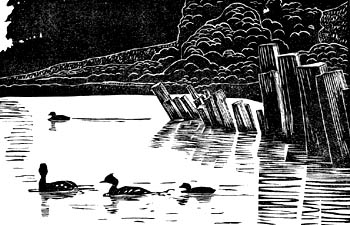![[MetroActive Arts]](/arts/gifs/art468.gif)
[ Arts Index | Santa Cruz Week | MetroActive Central | Archives ]
Water World
A group of Central Coast artists mine the Watsonville slough system for art
By Andrea Perkins
BEHIND A CROOKED GATE wrapped in fog, silvery slough water has reclaimed an asphalt road. A bent road sign, reflected in the swollen waters, appears stranded--the lingering, woebegone token of a lost civilization. Here, nature has triumphed.
Carol Whitehill's evocative black-and-white photograph, Road Closed, captures the victory with simple elegance. It's a ghostly glimpse into the teeming world of Harkins Slough, one of six main sloughs that make up Watsonville's wetlands.
Each of the 74 artworks at Pajaro Valley Gallery opens a window onto this vast ecosystem, which at 800 acres is the largest freshwater slough system in coastal California. Even so, many of the show's 47 Central Coast artists had never visited the sloughs prior to being invited to participate in the show. According to Mary Warshaw, who co-curated the exhibit with Louise Newberry, some weren't even quite sure how to get there.
"Some artists we invited were like, 'Do you mean the Elkhorn Slough?'" laughs Warshaw. "We had to send them maps and directions."
For many, depicting the sloughs wasn't about flexing perceptions of familiar terrain as much as committing an act of pure discovery--something the exhibit's title, "Discovering the Watsonville Sloughs," aptly reflects. An element of curiosity runs like a rich vein through much of the work, creating in the viewer a contagious desire to personally visit the sloughs. But this is the only thing these pieces have in common.
Some are variations on a theme; luscious landscapes traditionally executed with pastels, watercolors or oils. Ann Thiermann's pastels on sandpaper portray the Struve Slough with a vivid, almost hallucinogenic softness. Gunnars Berlings uses pastels and acrylic ink to capture the rosy autumnal light-play of sky, land and water, even delicately depicting smokestacks and encroaching development.
In a exhibit in which landscapes dominate, only a few imprint themselves upon the memory. The clean brushstrokes and strong reds and yellows of Bill Fenwick's handsome Bye Bye Birdland re-create bright, mounded hills and bold tree-bordered waters that buzz with heat and light, but seem abandoned by life.
Howard Ikemoto's watercolors and charcoal sketches grab the eye, as does Richard Bennett's large oil which captures curve and grandeur with a simple palette of burnished hues. The bruised skies and bleeding colors of Qin-Ming Hay's dim, moody watercolors are also arresting, as is Gypsy Ray's Reeds, a haiku shot with a pinhole camera.
OTHER WORKS move in strict counterpoint to all pastoralisms. Robert Larson takes a visceral look at human impact on the sloughs. His "scavenge journal," a book of photographs of submerged shopping carts and other debris, gives voice to the environmental degradation that threatens the area. His sculpture, California Adobe, a cube of mud embedded with fast food wrappers and Pez dispensers, is artistically blasé, but packs a persuasive anti-pollution punch.
Julie Connell's beautiful monoprints Camouflage 1 and 2 are full of flight. Silhouettes of birds are laid upon a background flooded with light, hinting at the translucence common to some Asian art.
Another diptych, Norman Locks' Struve Slough from Main, has a wonderful whiplash effect. Polaroids taken from slightly different angles, then printed large with an ink jet, have an effect akin to the Technicolor eight millimeter film of the '60s.
One of the most immediately gratifying pieces in the show is Bob Lyon's Pajaro 2001, a totemlike wooden sculpture of a bird with sharp crescent wings, adorned with seashells, bones, rusted metal, glass, rocks, old rotary phones and other recycled materials discovered at the sloughs.
Also included in the show are stuffed birds and other natural history displays borrowed from the Pacific Grove and Santa Cruz natural history museums. There are also original woodcuts, not to mention an actual wood block, from Andrea Rich and interesting scientific illustrations by Janice Bridgman and Mary Sievert. Other wonderful works were made by sixth-graders from the Pajaro Watershed Institute, an after-school program at Pajaro Middle School sponsored by the Pajaro Valley Art Council.
The exhibition succeeds in discovering one of the region's most neglected environmental treasures and gazing at it from as many different angles as possible. The result is profound and panoramic, leaving the viewer feeling sublimely saturated. It is a beautiful way to call public attention to a priceless and endangered area in a state that has already lost 90 percent of its wetlands.
Copyright © Metro Publishing Inc. Maintained by Boulevards New Media.
![]()

Duck Duck Goose: 'Harkins Slough' is one of four woodcuts by Andrea Rich on exhibit at Pajaro Valley Gallery.
Discovering the Watsonville Sloughs is at Pajaro Valley Gallery, 37 Sudden St., Watsonville, through March 3. Gallery hours are 12:30-4:30pm Wednesday-Saturday; admission free; 722.3062.
From the February 7-14, 2001 issue of Metro Santa Cruz.